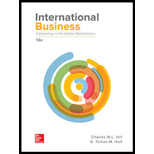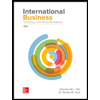
International Business: Competing in the Global Marketplace
12th Edition
ISBN: 9781259929441
Author: Charles W. L. Hill Dr, G. Tomas M. Hult
Publisher: McGraw-Hill Education
expand_more
expand_more
format_list_bulleted
Question
Chapter 13, Problem 1CTD
Summary Introduction
To Discuss: The reasons on zero transportation costs, no trade barriers and significant similarities among countries with regard to factor conditions firms should increase internationally in order to survive.
Introduction: Transportation costs are the costs caused by a worker or independently employed taxpayers when far from home in a transportable status for business. Transportation costs are a subdivision of transportable costs, which are generally costs, related with business travel, for example, taxi charges, gasoline, parking expenses, phone charges that representatives may acquire and guarantee for repayment.
Expert Solution & Answer
Want to see the full answer?
Check out a sample textbook solution
Students have asked these similar questions
Explain the two opposing forces—cost reduction and adaptation to local markets—that firms must deal with when they go global and explain the four basic strategies that may be used in relation to the pressure from each of the opposing forces
Specifically, this insert begins with the conjecture that at this juncture, opinions differ on the future of IB and globalization, but that three scenarios predominate, specifically:
Further globalization is inevitable.
IB will grow primarily along regional rather than global lines.
Powerful forces opposing further globalization and IB will slow their growth.
Against this backdrop, some observers feel that people who work for international institutions, such as the World Bank or WTO, cannot adequately manage the complexities of an interconnected world.
Based on this, one can reasonably conclude that these observers they anticipate that ________.
A) globalization will slow in the future
B) international business will grow primarily on a regional basis
C) private companies will replace international organizations in running the world's economy.
D) globalization is inarguably inevitable
The suggestion is that worldwide industries were transformed in the 1980s and 1990s from traditional multinational, international, and global firms into transnational firms. Explain why this was necessary and whether the intended purpose was achieved? You are required to address the special features and attributes of a typical transnational firm?
Chapter 13 Solutions
International Business: Competing in the Global Marketplace
Knowledge Booster
Similar questions
- Who benefits from Boeings decision to outsource component part manufacturing assembly to other nations. Who are the potential losers?arrow_forwardDescribe the current global strategy for Estee Lauder and provide evidence about how the firm’s resources andcompetencies support the pressures regarding costs and local responsiveness. Describe entry modes they haveusually used, and whether the modes are appropriate for the given strategy. Should the company go global? If so,what do they need to consider. If not, why?arrow_forwardFrom the following, please identify the 2 statements that are true as well as the 2 statements that are false. A) Critics of globalization claim that increasing cross-national integration fortifies countries' sovereignty B) International operations may increase operating risk by smoothing sales and C) Foreign sources may give companies additional operating knowledge D)Although foreign external environmental differences are problematic, they must be weighed against domestic opportunities and risks.arrow_forward
- Comment on your friend’s statement that manufacturing in China cannot catch up with that in Vietnam after Samsung’s opening factory in Vietnam. Why do Vietnamese businesses have limited relationship with Samsung?arrow_forwardUsing the “Diamond Model” describe the key elements using Netflix’s global presence. Demand Conditions Factor Conditions Related and Supporting Industries Strategy, Structure, and Rivalry Select one of the types of international strategies that you believe applies to Netflix. Provide evidence and justification for your selection. Make sure to fill out the references slide for the information you are presenting.arrow_forwarda.Overview of the five (5) entrance modes, which include exporting, licensing deals, partnering and strategic alliances, acquisitions, and the establishment of new, totally owned subsidiaries, commonly known as greenfield ventures.Analysis and justification of the company's and the tumeric soap's chosen international market entry strategy in Germany. b.Propose an international strategy based on multi-national, global, or transnational strategies. The company and the tumeric soap that was chosen as the product on the international market in Germany.arrow_forward
- Suppose DAK Corporation plans to open its factories in Brazil, where culture and socio-economic context isdramatically different from other countries. Critically examine the strategic options you will adopt as a Global StrategyHead of DAK Corporation if Brazil is considered as a Turbulent and High Velocity Market. Your answer should includeelaborate analysis of the moves DAK corporation needs to follow in order to succeed in such marketsarrow_forwardJanet has to make decisions as it relates to producing goods for sale in the international market. She has decided to use foreign suppliers and assemble the components at the parent company. The production strategy being utilized is _______________________ 2. All of the following are important to global managers except: a. The ability to network across borders b. Experience working in a foreign country c. Money d. Knowledge of your job role effectively 3. Reasons for international trade include all except: a. Increasing returns to scale b. No difference in the capital stock c. Differences in technology d. Difference in demandarrow_forwardYou are the CEO of Elegant Electronix and you are contemplating expanding in Japan .You have all the resources to start from scratch in that country .Discuss the many advantages to initiating , continuing and or expanding international operations. outline disadvantages alsoarrow_forward
- The competitive strategy of a firm pursuing a transnational, "think global, act local" approach to strategy making A) usually involves cross-subsidizing the prices in those markets where there are significant country-to-country differences in the product attributes that customers are most interested in. B) involves having strongly differentiated product versions for different countries and selling them under distinctly different brand names so that there will be no doubt in customers' minds that the product is more local than global. C) is essentially the same in all country markets where it competes but it may give local managers room to make minor variations where necessary to better match local market conditions. D) entails little or no strategy coordination across countries. E)involves selling a mostly standardized product worldwide, but varying a company's use of distribution channels and marketing approaches to accommodate local market conditions.arrow_forwardChoose any international company that has outsourced one of its business functions to a local company in their international operation (For example DHL’s use of a local Indian company for its inbound freight distribution in India) and critically discuss the benefits and drawbacks of its outsourcing arrangement with the local company. An outsourcing arrangement between the two companies should post 2010. (500 words)arrow_forwardYou are an International Business Consultancy and Nokero is a marketer pf solar light bulbs, and exports them all over the world. he is thinking about expanding to the caribbean and has asked you to investigate the possibility of expanding toBarbados. Recommend to Nokero which international business strategy (s) to use. choose from multidomestic, global, and transnationalwhy is the chosen strategy better than the others. Justify your choices.arrow_forward
arrow_back_ios
SEE MORE QUESTIONS
arrow_forward_ios
Recommended textbooks for you
 BUSN 11 Introduction to Business Student EditionBusinessISBN:9781337407137Author:KellyPublisher:Cengage Learning
BUSN 11 Introduction to Business Student EditionBusinessISBN:9781337407137Author:KellyPublisher:Cengage Learning Essentials of Business Communication (MindTap Cou...BusinessISBN:9781337386494Author:Mary Ellen Guffey, Dana LoewyPublisher:Cengage Learning
Essentials of Business Communication (MindTap Cou...BusinessISBN:9781337386494Author:Mary Ellen Guffey, Dana LoewyPublisher:Cengage Learning Accounting Information Systems (14th Edition)BusinessISBN:9780134474021Author:Marshall B. Romney, Paul J. SteinbartPublisher:PEARSON
Accounting Information Systems (14th Edition)BusinessISBN:9780134474021Author:Marshall B. Romney, Paul J. SteinbartPublisher:PEARSON
 International Business: Competing in the Global M...BusinessISBN:9781259929441Author:Charles W. L. Hill Dr, G. Tomas M. HultPublisher:McGraw-Hill Education
International Business: Competing in the Global M...BusinessISBN:9781259929441Author:Charles W. L. Hill Dr, G. Tomas M. HultPublisher:McGraw-Hill Education

BUSN 11 Introduction to Business Student Edition
Business
ISBN:9781337407137
Author:Kelly
Publisher:Cengage Learning

Essentials of Business Communication (MindTap Cou...
Business
ISBN:9781337386494
Author:Mary Ellen Guffey, Dana Loewy
Publisher:Cengage Learning

Accounting Information Systems (14th Edition)
Business
ISBN:9780134474021
Author:Marshall B. Romney, Paul J. Steinbart
Publisher:PEARSON


International Business: Competing in the Global M...
Business
ISBN:9781259929441
Author:Charles W. L. Hill Dr, G. Tomas M. Hult
Publisher:McGraw-Hill Education
